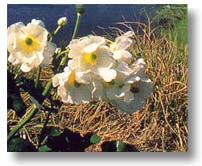|
2. Clinton Ravine-Bursting with Flowers in the Early Summer
This time, I chose early summer-the middle of December-for my trip.
On the second day, the other hikers and I leisurely walked 16 km along the ravine, through beech forests and swamps, looking at flowers and birds.
After breakfast, we left the hut in small groups, carrying sandwiches and snacks. At noon, we stopped at a small hut and had lunch with hot soup and tea.
The mischievous kea birds stole the sandwiches of some of the people in our group.

Fishing in the Clinton River
Copyright1998 Shiro Watanabe
|
The area was overflowing with blooming flowers under the blue sky, with singing birds and mountaintops covered with snow. In the clear waters of the Clinton mountain torrent, people were enjoying fly-fishing for large trout that were swimming calmly in the water.
The native flowers, such as Mt. Cook lilies and daisies, were either white or yellow and were small and delicate.
The white was sharp and clear like the glaciers of several tens of thousands of years ago. Depending on the type of flower, the tint and texture were slightly different.
There were also white flowers which seemed faintly dyed with the deep blue of the sky and the deep green of the trees.

Mt. Cook lilies
Copyright1998 Shiro Watanabe
|
Butterflies are rare, but there are many moths in New Zealand.
The moths fly and pollinate flowers only during the brightest time of the day. They have a thousand-year old survival instinct which draws them to the white and yellow flowers, which most strongly reflect sunlight. They say that's why there are only white and yellow flowers left now.
When we arrived at the next mountain hut, afternoon tea was ready for us. We left our packs in the clean, four-person room, washed clothes, showered, and took a short break.
For our evening meal, wine, a large meal, and many different kinds of dessert were served. We spent our time chatting and playing cards in the lounge, with the fireplace roaring, or outside looking at the stars. The schedule was set for lights out at 10 p.m.
Even though the walk is limited to 48 people per day and the period from November to March, the ecology of the region is changing little by little because eggs, seeds, and other organisms are carried in with visitors. No four-legged creatures used to live in the area, but now large, non-native rats overeat, destroying the native tree roots, insects, etc.
In the lowlands, the thickly growing yellow Scotch brooms and red and blue lupines are uninvited visitors from England. Recently, lotus flowers and dandelions from Japan also grow in abundance.
Four years ago, the guide said the clear mountain torrent would probably become muddy sooner or later; however, fortunately, the water was still clean when I was there.
I guess because the walks are commercialized, it's impossible to avoid some changes.
After all, they have a history of a hundred years.
Links
Milford
Copyright1998 Setsuko Watanabe
|



